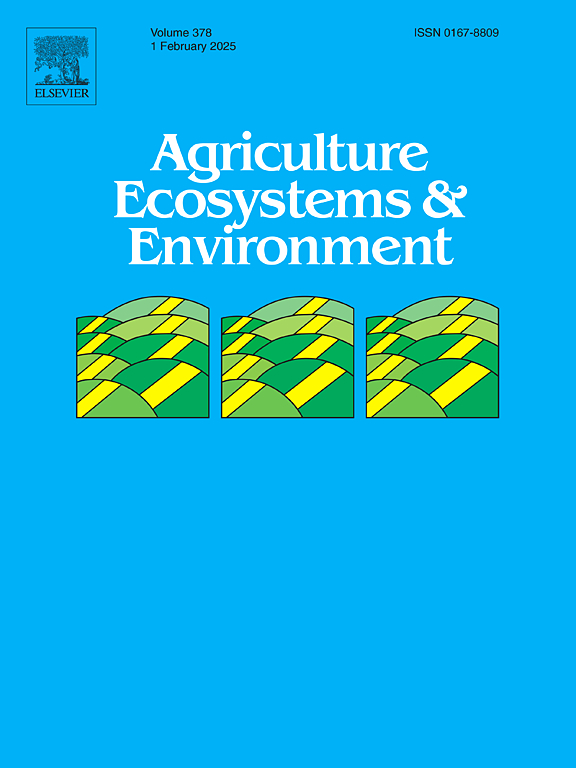地下施用控释混合肥料通过促进稻田氮素转化来减轻氨挥发
IF 6
1区 农林科学
Q1 AGRICULTURE, MULTIDISCIPLINARY
引用次数: 0
摘要
稻田氨挥发是施肥后氮素损失的主要来源,但可以通过使用控释混合肥料来减轻这一损失,这种肥料可以根据作物需求同步释放养分。因此,本研究是在连续两个水稻生长季节进行的;将3种控释混合肥料与推荐肥料和简单混合肥料进行比较,评价其对稻田氨挥发、氮素转化和作物生产性能的影响。结果表明,与推荐肥和简单混肥处理相比,施用控释混肥显著改善了土壤动态,提高了产量和产量成分,增加了碱氮和铵浓度,降低了硝酸盐水平和氨挥发。此外,控释掺混肥料通过激活氮素代谢酶,包括硝酸盐还原酶、亚硝酸盐还原酶、谷氨酰胺合成酶和谷氨酸合成酶,提高水稻氮素吸收和氮素回收效率,并上调编码氮素代谢的基因NRT2.1、AMT1、GS1和GOGAT1的表达水平,促进氮素的同化和利用。此外,控释混合肥料改进剂促进了水稻根际土壤蛋白酶、纤维素酶和脱氢酶的活性,促进了氮素循环,减少了氮素损失。在这两年中,控释混肥处理中,50% %的氯化钾源钾肥减少了37 %,氨挥发减少了37 %,氮吸收增加了39 %;随后,施用50% %的硝酸钾源钾肥,氨挥发减少了27 %,氮吸收增加了25 %。树脂硝酸钾源中添加100% %钾肥处理,可使氨挥发减少24% %,氮素吸收增加22% %。综上所述,控释混合肥料实现了养分有效性和植株需要量的最佳平衡,提高了氮素利用效率。综上所述,稻田施用控释混肥可提高氮素利用效率,减少氮素损失,增强土壤健康,通过减少氨挥发,提高水稻产量,使水稻种植更具可持续性。本文章由计算机程序翻译,如有差异,请以英文原文为准。
Subsurface placement of controlled-release blended fertilizers mitigates ammonia volatilization by promoting nitrogen transformation in rice fields
Ammonia volatilization from rice fields is a major source of nitrogen loss following fertilizer application, but it can be mitigated by using controlled-release blended fertilizers, which synchronize nutrients release according to crop demand. Therefore, the current study was conducted for two consecutive rice-growing seasons; three levels of controlled-release blended fertilizers were compared with recommended fertilizers and simple blended fertilizers to evaluate their impact on ammonia volatilization, nitrogen transformation, and crop performance in rice fields. The results indicates that the application of controlled-release blended fertilizers significantly improved soil dynamics, enhances yield and yield components, increasing alkali nitrogen and ammonium concentration while reducing nitrate levels and ammonia volatilization compared to recommended fertilizers and simple blended fertilizers treatments. Furthermore, controlled-release blended fertilizers amendments boost nitrogen uptake and nitrogen recovery efficiency in rice plants by activating nitrogen metabolism enzymes, including nitrate reductase, nitrite reductase, glutamine synthetase, and glutamate synthase, and upregulated the expression level of genes encoding nitrogen metabolism (NRT2.1, AMT1, GS1, and GOGAT1) which facilitated better nitrogen assimilation and utilization. Additionally, controlled-release blended fertilizers amendments stimulated soil enzyme activities, such as protease, cellulase, and dehydrogenase, in rice rhizosphere soil, improving nitrogen cycling and reducing nitrogen losses. During both years, controlled-release blended fertilizer treatment with 50 % reduced potash from potassium chloride source, decreased ammonia volatilization by 37 % and increased nitrogen uptake by 39 %, followed by treatment with 50 % reduced potash from potassium nitrate source, decreasing ammonia volatilization by 27 % and improving nitrogen uptake by 25 %. The treatment with 100 % potash from resin potassium nitrate source alleviated ammonia volatilization by 24 % and enhanced nitrogen uptake by 22 %, respectively. These findings suggest that controlled-release blended fertilizers achieves the optimal balance between nutrient availability and plant demand, improving nitrogen use efficiency. In summary, controlled-release blended fertilizers application to rice fields improves nitrogen use efficiency, reduce losses of nitrogen and enhances soil health, making rice cultivation more sustainable by decreasing ammonia volatilization and increasing rice yield.
求助全文
通过发布文献求助,成功后即可免费获取论文全文。
去求助
来源期刊

Agriculture, Ecosystems & Environment
环境科学-环境科学
CiteScore
11.70
自引率
9.10%
发文量
392
审稿时长
26 days
期刊介绍:
Agriculture, Ecosystems and Environment publishes scientific articles dealing with the interface between agroecosystems and the natural environment, specifically how agriculture influences the environment and how changes in that environment impact agroecosystems. Preference is given to papers from experimental and observational research at the field, system or landscape level, from studies that enhance our understanding of processes using data-based biophysical modelling, and papers that bridge scientific disciplines and integrate knowledge. All papers should be placed in an international or wide comparative context.
 求助内容:
求助内容: 应助结果提醒方式:
应助结果提醒方式:


